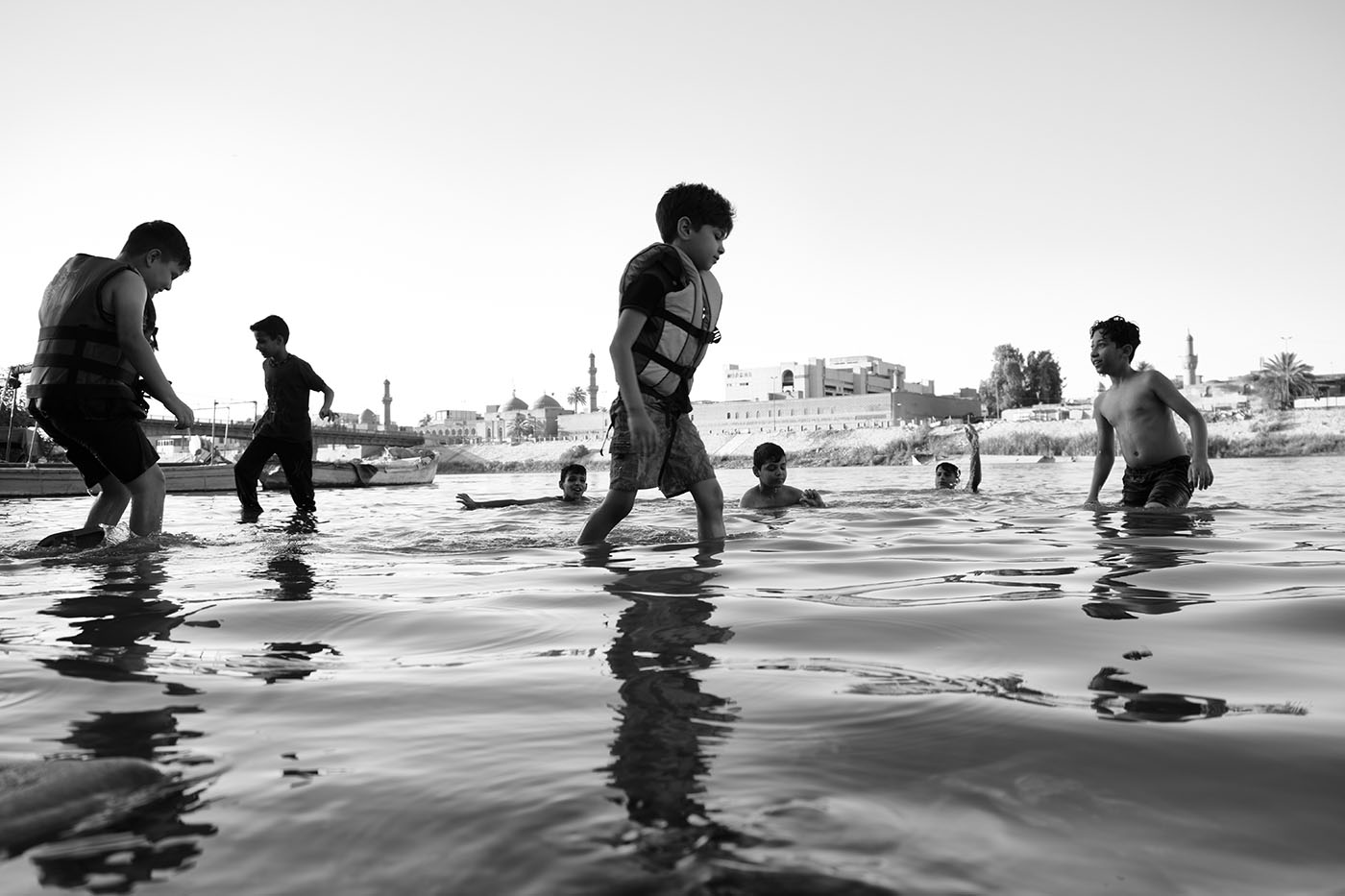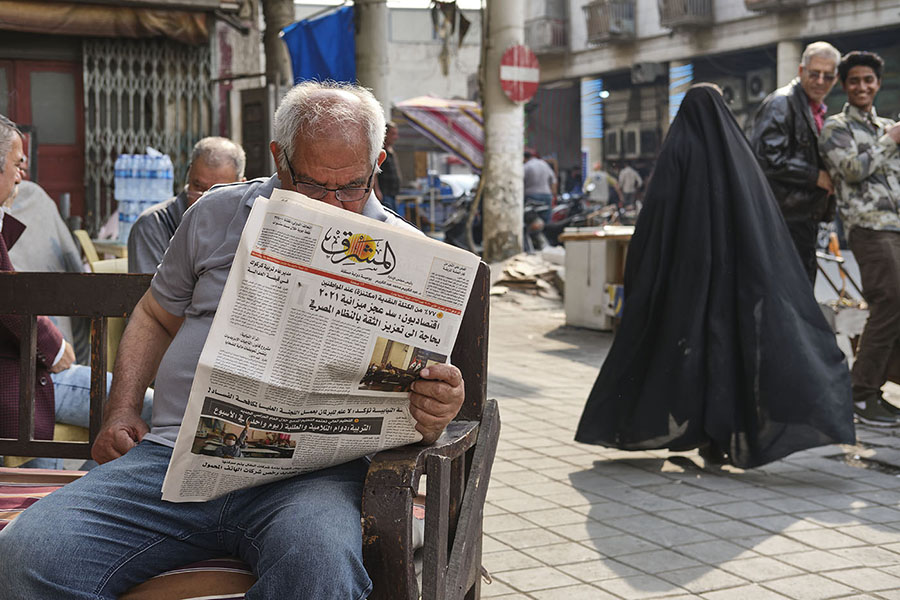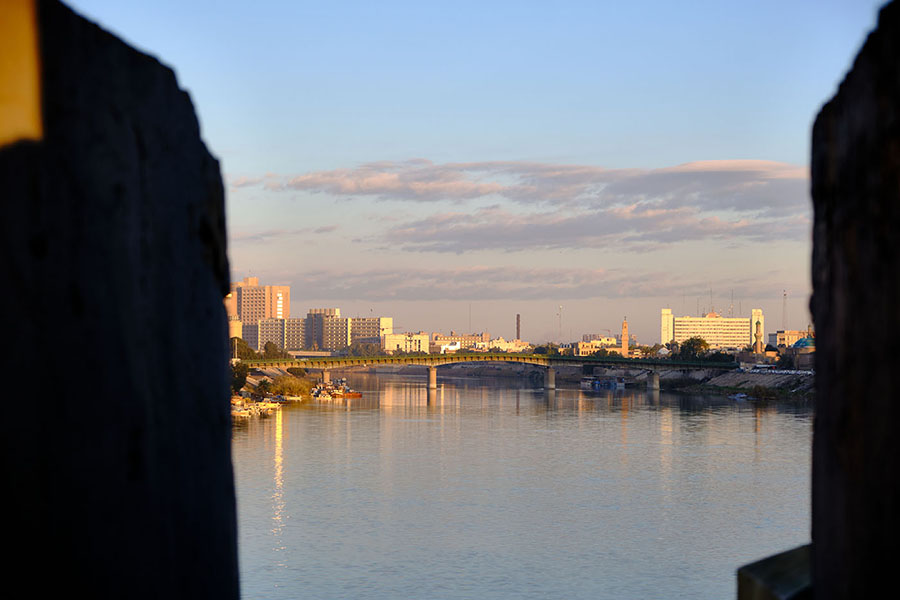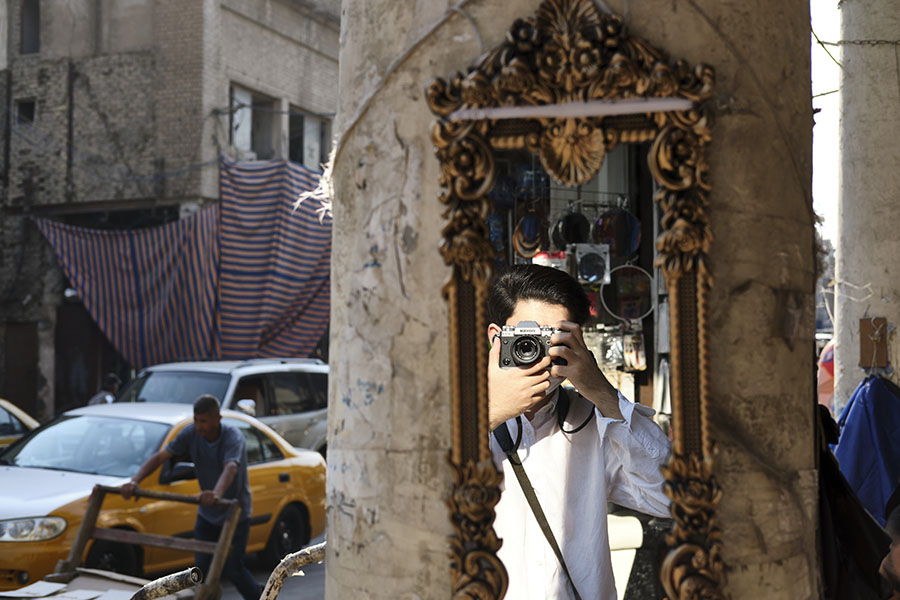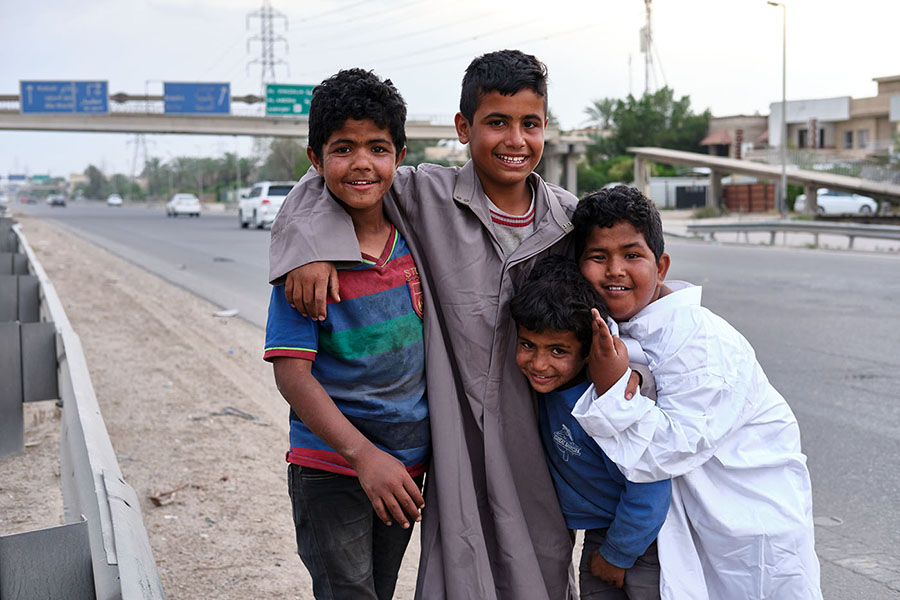In memory of those left behind, of our beloved and the unremembered.
Nabil Salih
In our guest room hung a portrait of a man*. He was young, had a solemn look, elegant in his suit and tie. His gaze, however, was orphaned, unmet, and in-waiting. He was ever-present, yet seldom spoken of or remembered overtly.
My late grandmother, forever in black, would sob in the evenings. We, children, neither received nor needed an explanation. From the same room where we huddled during American air raids, undulating lamentations would sway into the living room and the kitchen where we dined.
As for him, sleepless as he was, he could no longer hear. A forbidden secret, his name was rarely articulated. As if effaced from the registry; no family story segued into a mention of his whereabouts. Only his photograph was there, mute, waiting in vain to speak. From this troubled quietude I could only grasp absence.
All I later learned was that ammu Tariq, my late uncle, had been a communist executed or forcibly disappeared in the early 1980s with other comrades in the family. For when Saddam Hussein seized power in 1979, he’d ushered in another episode of purges against the Iraqi Communist Party (ICP).
In her book Return to Ruin: Iraqi Narratives of Exile and Nostalgia, Zainab Saleh writes of her father’s final years. “A staunch supporter” of the ICP, he passed away in 1982 while still burdened by what she believes was survivor’s guilt:
He mainly lamented the liquidation of the ICP in the late 1970s and the death and disappearance of some of his close friends. He sometimes banged his head against the wall as he talked about the fate of his friends. He often wished that he had died before witnessing these developments and talked about how the struggle of his generation was forestalled by the European- and U.S.-backed reign of Saddam Hussein.
Among so many Iraqis, the ICP was mythical, celebrated in song and poem. Decades of repression did little to diminish its relevance. Even when legendary comrade Yusuf Salman Yusuf was hanged after the wathba uprising in 1949, Hanna Batatu writes, the ICP became “surrounded with the halo of martyrdom.”
Tariq was quiet; he sipped arak with his comrades in the garden and, as my aunt once told me, wrote poems destined to be unread and lost. Against the family’s advice, he would amble back from his work at a state-run dairy factory with the ICP newspaper spread before his face. Then one day he went to work and never came back.
(The telephone rings. My aunt picks up. Someone’s voice says Tariq is never coming back. His uncle, a medical doctor, was arrested on the same day).
In front of the photograph of my mother as a child, I tell myself: she is going to die: I shudder, like Winnicott’s psychotic patient, over a catastrophe which has already occurred. Whether or not the subject is already dead, every photograph is this catastrophe. — Roland Barthes, Camera Lucida
Until the occupation of Baghdad in 2003, there was never a body to go along with his death. When the mass graves of the dictator were beginning to be exhumed, the family acquired archival documents that said Tariq was executed in 1984. My grandmother finally experienced a sense of closure: an empty grave on which to grieve.
In the 1980s, Hussein’s apparatchiks would come knocking on the door: “Where is he?” they would ask. But they knew very well where he was; having sent him “behind the sun,” they were only there to torment his family. My aunt faced pressure by Ba’athists at work to proselytize, and my father was denied a state job.
Growing up in the 1990s, my family’s fear was passed on to us children. We were warned not to let slip the little we knew of Tariq in school. There, our classrooms had broken windows, and we shuddered from the cold. Each class would start by us half-heartedly reciting an elongated “Long Live the Leader Saddam Hussein!” His watchful eyes sent ominous looks from portraits adorning the school walls and the pages of our worn textbooks.
Hussein was also a family member. No space remained immune to the penetration of his voyeuristic gaze. The city’s walls were a canvas of his likeness, tattooed with variations of his triumphant grin. In people’s homes, his image decorated living rooms as a cacophony of his dull speeches played on television screens ad infinitum.

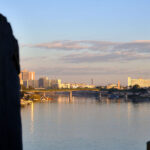
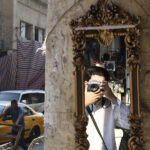
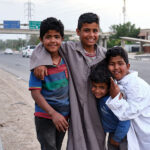
In our house, Tariq looked on as the guest room was slowly emptied of its furniture. After the Gulf War came the sanctions, economically strangling a population already on its knees. Families plied their house items on the streets, selling even their cameras for a song. Baghdad’s nights became dark and long; the time for parties was over. Guests and hosts were now abroad, disappeared, or dead. The record player went silent, the sofas shipped away.
Our photo albums all contain gaps: the missing, unpictured decade of the 1990s.
The weight of United Nations Security Council Resolution 661 was unbearable. Barring a few exceptions, export and import were forbidden. Iraq could not receive any funds from abroad and every UN member state was obligated to participate in enforcing this “humane and humanitarian” starvation.
Iraq was grappling with an entire host of such Orwellian realities imposed on it from the outside. It was, after all, a nation that had just undergone a surgical war that, inter alia, devastated water purification plants and the power grid, sowed its soil with Depleted Uranium for future generations and, infamously, incinerated hundreds of civilians in the al-Amiriyah bomb shelter, including Tariq’s aunt and cousins.
In war’s aftermath, madmen roamed the streets and anguished mothers the grim hospital wards. One million children suffered malnourishment; 70% of women were anemic. “Whether the number of child deaths was 200,000 or 500,000,” writes Joy Gordon in Invisible War, “the magnitude of the harm was enormous, and it was always known to be enormous” — and now forgotten, too.
Sanawat al-hisar, the years of the embargo, were especially long on the women who had just parted with lovers, buried or hoped to give a dignified burial to brothers, fathers and sons whose bodies littered the desert of the south: a frontline of many wars now roamed by the lost ghosts of the soldiers who died thirsty and alone.
These were long years on my own late mother too; like so many Iraqi women, she was a teacher whose pay was reduced to near nothingness. Many could not even afford to go to work and were pushed to eke out their domestic life instead. To make ends meet, my mother sewed and tutored at home, the rhythmic sound of her sewing machine bearing the family off to sleep every night.
One night not so long ago, reading Charles Simic, I heard my mother’s sewing machine running again. The sound that echoed down the long-gone years compelled me to raise my head towards the nightstand where I keep a photograph of my mother in the folds of a pocket-size copy of the Quran.
My Mother Hoped
To take her sewing machine
Down into her grave,
And I believe she did that,
’Cause every now and then
It keeps me awake at night.
I then buried my head in the pillow, pretending not to hear.
Though my mother’s picture has been sitting on my nightstand, just beside my bed for near three years, rarely do I dare pull it out to look at it. Unconsciously, it is as if a veil keeps the corner where the nightstand, with the Quran and the photograph it carries, out of my sightline. But while the picture is hidden, its authority is not.
Now my fingertips linger over this keyboard’s surface. The photograph in hand is an impenetrable passage back to a day about which I almost know nothing. The stamp on the back reveals only the name of the studio (al-Junayna) and my neighborhood’s address in western Baghdad. There is nothing about the date of the visit.
I assume it was taken in the early 1980s, while the Iran war raged on. Perhaps my father was on the frontline. In the late 1970s, his family moved from the riverine Karradat Maryam neighborhood (part of it would later be swallowed into the Green Zone) to the western suburb where I grew up. The newly wedded couple, as is the custom, moved in.
In this photograph, my mother’s face glows. Her eyes, captivating, are fixed on a point above the camera’s. Not yet in her hijab, she wears a woolen blouse for what I assume was a chilly day. Her lips are closed (a habit I would inherit myself), and she — just as I knew her — is reservedly confident.
The absence of hijab indicates that the photograph was taken during a time predating the Faith Campaign. After the Gulf War and the imposition of sanctions, Hussein feared for his dying hegemony as beleaguered Iraqis embraced religiosity for solace. He promoted a state-sponsored and controlled version of Islam, allowing its symbolism, monuments and discourse to suffuse the public and urban spheres. Thus Ba’athism’s secularist principles were reversed, instead returning to the embrace of the tribe and Islam.
That aside, no single detail in her photograph arises, as Roland Barthes would say, from the scene to pierce me like an arrow. Time is one of these elements that assail and wound, what he called punctum: my mother has long been dead. But it is also a living death, one that casts a vertiginous spell and disturbs.
Instead, I long for the totality of her, for the touch of her blouse’s fabric, the sound of her footsteps walking in, her voice speaking, her thoughts posing for the camera, how she spent the remainder of her day. But the photograph is an impassable passage in time.
Unlike a portrait of a familiar strip of urban space I often walked and still roam through the haunted streets of memory, the impassability of my mother’s claustrophobic photograph is also a consequence of an unlived time. I have never met my mother in her youth, and thus a temporal abyss is opened between then and now.
In his essay On Some Motifs In Baudelaire, Walter Benjamin writes of the “decline of the aura” in photography. Unlike photographs, when a fleeting scene of mémoire involontaire flits by, a halo of associations gathers around an object of perception. To experience its aura, an object must return our gaze from a distance.
But my mother is not seeing me, I cannot be with her. It is her living death, then, and the unfulfilled promise of a rendezvous in the photograph that haunt and intimidate.
When war revisited Iraq for a longer stay in 2003, cluster bombs rained over our house. Once a site of beautiful memories, the luscious garden where we would have lunch during sunny springtime days was withered by war. The rooftop where we’d once slept our summer nights, watching the palm fronds dancing to the nocturnal flirtations of the wind was riddled with bullet holes and scarred with shrapnel. Even the trunk of our palm tree was wounded. Our house was repeatedly desecrated, along with our privacy. For, nestled near an international highway and an adjacent overpass, patrolling US troops often occupied our rooftop and turned it into a watchtower of their expanding empire. At times, they would come barging through the door, pounding up the stairs as my mother, startled, dashed into her room to fetch a scarf.
When I look at the elegant woman in the photograph I can’t help but also see how the world surrounding her was destined to crumble. How her husband, my father, would be kidnapped, their friends and relatives murdered; the clashes that would erupt outside her door, the corpses dumped on sidewalks that she would encounter, and, in a time of sectarian cleansing, the letter she would find in an envelope left on our doorstep. We had three days to leave, it said, or else we would die.
On one of these wartime days, she braved the ever-looming threat of clashes to visit one of the few grocery stores left open in the mayhem. Men always feared abduction, assassination or arrest, so sometimes it was wiser for women to be the ones to venture out of the house. As I stood by the front door waiting for her, an explosion plowed the soil around the corner and sent it skyward.
(Silence after the thundering of the blast. I run. The debris comes falling from the sky).
A roadside bomb had been detonated as a coalition convoy entered the neighborhood, shredding a Humvee with whomever it carried inside. As I waited to hear news of my mother, the moments lasted an eternity. Had she been on her way back with her bags, about to cross the street as the convoy brushed by her side?
My mother returned safely. At the site of the explosion, a gaping crater would silently scream for weeks. As punishment for each such incident, the bowels of Abu Ghraib prison needed to be fed with thousands. Unable to control Iraqi cities, people were scooped off the streets and thrown into “Gitmoized” jails.
Women, of course, were not spared. Not only were female reporters, academics and doctors murdered and exiled, but as Haifa Zangana narrates in City of Widows, American troops raped women and, in an abyss of Abu Ghraib’s depth, even rode a seventy-year-old woman like a donkey:
In addition to suffering the same hardships as male inmates, the women endure another plight: silence. First, the denial by occupation authorities that there are female detainees at all; and second, silence from the women’s own families because of the stigma surrounding the arrest and detention of a woman. For most Iraqis, the horrifying photos of Abu Ghraib signify not only the abuse and torture of the inmates but also the nightmarish reality of what has not been photographed or published: the torture and rape of their daughters, sisters, and mothers.
Such generational violence saturates the photographs of Iraqis. Even the happiest photographs are haunted by the implicit promise of impending doom, hovering around the smiling subject like an omen.
After 2003, however, the violent death of both humans and places surged to the foreground of every photograph, became the entirety of our lives. Images of torment and abuse replaced and erased those of laughter. Every serene park, market and street corner became a crime scene, smelling of gunpowder and ash — memories of happier days having been condemned to oblivion.
To many, images of Abu Ghraib are synonymous with Iraq. Women clad in black and beating hard on their faces and chests at sites of carnage and hospital gates are the archetypal visualization of the Iraqi self: defeated. Like a prized booty from the wreckage of history, this framed defeat is dusted off by some guilt-ridden photojournalists every March 20th.
For, it seems, atonement and repair in the Global North require a re-violation of the nameless, muted Iraqi self whose curated suffering is a commodity lucrative even post death. To express their solidarity with us requires them to make a spectacle of our humiliation, to parade it mournfully across a screen to the pace of a white man’s or woman’s regretful voiceover. The life-size images of degraded Abu Ghraib inmates in Jean-Jacques Lebel’s installation Poison Soluble at the 12th Berlin Biennale are but one example of regret-as-art, humiliation-as-atonement.
Jean Baudrillard knew this breed all too well. This solidarity, he writes in No Pity for Sarajevo, implies condensation and belies a “self-pity and a way of absolving one’s own powerlessness.” If something needs to be done, start at home, not where the “blood flows.”
Writing in Regarding the Torture of Others on the images of Abu Ghraib as the scandal seeped from the “unwinnable folly” (never a crime, of course, but would a winnable “folly” be less evil?) that was the Iraq war, Susan Sontag is worried that “the pictures will continue to ‘assault’ us.” They will “not go away.”
Sontag was writing for the readership of the New York Times Magazine. To her credit, she admits the images were not an aberration, that “the photographs are us” (Americans). But as Judith Butler says, she was also a self-preoccupied liberal livid at disturbing images giving no direction towards political action.
This self-preoccupation, she writes, prevents one from adequately responding to the suffering of others. But Sontag was doing something, Butler was right. She did so by writing about the photographs with both eloquence and American-centrism.
But what of our own reckonings, our own photographs? Not from Abu Ghraib alone, but from our everyday lives, which continued to unfold beyond its infamous walls before, during and after the bombs fell. What about the childhood recollections that I try to shield from the howls of sirens, the way the photo of ammu Tariq is haunted by his disappearance, and my mother’s by her own commonplace death?
For twenty-one-years Iraq and its people have been living in war’s afterlives, continuing to struggle in a land that is mahjouma. Our stories don’t end with the end of military operations, nor has the spectacle of violence been put to rest in our heads. We are instead now irreversibly damaged by less photogenic, less visible forms of violence inflicted by war pollutants, capitalism and a US-installed, malformed (dis)order. And it is against this abnormal existence that the October Uprising erupted in 2019. My mother was there, joining thousands of women on the streets. Hundreds of civilians were mowed down, hundreds of conmen grew richer.
Having survived decades of mayhem, my mother died in the summer of 2021 from a coronavirus infection. She closed her eyes for a last time at an “ideal” state hospital that nevertheless showcased every symptom of our failed state. A place where caretakers begged and bribed medical workers to do their jobs, the power went off for hours, fire extinguishers were nowhere in sight and both garbage and abandoned sick elderly were dumped in the hospital’s unkempt gardens.
In one of the last images I have of her — preserved only in my mind — my mother is being pushed to the mortuary refrigerator in the sun. Next she is at the local mosque, and dozens join us for salat al-janaza, a prayer for the dead we performed in the patio at dawn. My sisters stayed at home with the women, weeping.
(A cold breeze caressed the palm trees as we prayed, dampening our grief).
Next my mother is shrouded in white, and my brother and I are easing her into a narrow grave in western Baghdad.
I bought my ticket to Washington DC the day we buried her, leaving Baghdad the following week.
This photograph — with all the histories it contains — is all I have of her now.
*The author has not shared personal family photographs in this story out of discretion.
Further reading:
• Naomi Klein, The Shock Doctrine: The Rise of Disaster Capitalism, First Metropolitan paperback edition (New York: Metropolitan Books/Henry Holt, 2023)
• Haifa Zangana, City of Widows: An Iraqi Woman’s Account of War and Resistance, 1st trade pbk. ed (New York: Seven Stories, 2009)
• Walter Benjamin, Harry Zohn, and Hannah Arendt, Illuminations: Essays and Reflections (Boston ; New York: Mariner Books, Houghton Mifflin Harcourt, 2019)
• Roland Barthes et al., Camera Lucida: Reflections on Photography, Paperback ed (New York: Hill and Wang, 2010)
• Joy Gordon, Invisible War: The United States and the Iraq Sanctions (Cambridge, Mass.: Harvard Univ. Press, 2010)
• Hanna Batatu, The Old Social Classes and the Revolutionary Movements of Iraq: A Study of Iraq’s Old Landed and Commercial Classes and of Its Communists, Bacthists, and Free Officers (Princeton, New Jersey: PRINCETON UNIVERSITY PRESS, 1978), 569.
•Zainab Saleh, Return to Ruin: Iraqi Narratives of Exile and Nostalgia (Stanford, California: Stanford University Press, 2021)


